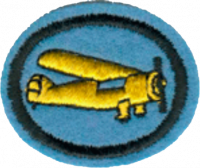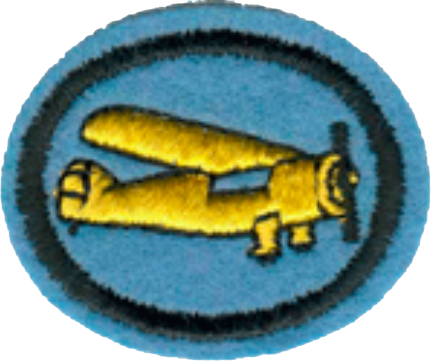Difference between revisions of "AY Honors/Airplane Modeling/Answer Key/es"
From Pathfinder Wiki
< AY Honors | Airplane ModelingAY Honors/Airplane Modeling/Answer Key/es
(Updating to match new version of source page) |
|||
| (36 intermediate revisions by 3 users not shown) | |||
| Line 1: | Line 1: | ||
| − | + | {{HonorSubpage}} | |
| − | + | ||
| − | {{ | + | <section begin="Body" /> |
| − | |||
| − | |||
| − | |||
| − | |||
| − | |||
| − | |||
| − | |||
| − | |||
| − | ==1. Construir y volar con éxito un avión de un kit de madera de balsa y papel, que sea propulsado por una banda de goma o por gas. | + | {{ansreq|page={{#titleparts:{{PAGENAME}}|2|1}}|num=1}} |
| + | <noinclude></noinclude><!-- instance 1 --> | ||
| + | <!-- 1. Construir y volar con éxito un avión de un kit de madera de balsa y papel, que sea propulsado por una banda de goma o por gas. --> | ||
{{clear}} | {{clear}} | ||
| Line 63: | Line 57: | ||
{{clear}} | {{clear}} | ||
| − | ==2. Construir un planeador con madera de balsa de un modelo prefabricado y observar sus características de vuelo en relación a la variable posición de las alas. | + | <noinclude></noinclude> |
| + | {{CloseReq}} <!-- 1 --> | ||
| + | {{ansreq|page={{#titleparts:{{PAGENAME}}|2|1}}|num=2}} | ||
| + | <noinclude></noinclude><!-- instance 1 --> | ||
| + | <!-- 2. Construir un planeador con madera de balsa de un modelo prefabricado y observar sus características de vuelo en relación a la variable posición de las alas. --> | ||
{{clear}} | {{clear}} | ||
| Line 177: | Line 175: | ||
{{clear}} | {{clear}} | ||
| − | ==3. Hacer y volar con éxito | + | <noinclude></noinclude> |
| + | {{CloseReq}} <!-- 2 --> | ||
| + | {{ansreq|page={{#titleparts:{{PAGENAME}}|2|1}}|num=3}} | ||
| + | <noinclude></noinclude><!-- instance 1 --> | ||
| + | <!-- 3. Hacer y volar con éxito dos diferentes estilos de aviones utilizando hojas de papel de entre 8 (20 cm) y 14 (35 cm) pulgadas de ancho y largo. --> | ||
{{clear}} | {{clear}} | ||
| Line 187: | Line 189: | ||
{{clear}} | {{clear}} | ||
| − | ==4. Definir, ubicar y explicar el uso de los siguientes elementos básicos: | + | <noinclude></noinclude> |
| + | {{CloseReq}} <!-- 3 --> | ||
| + | {{ansreq|page={{#titleparts:{{PAGENAME}}|2|1}}|num=4}} | ||
| + | <noinclude></noinclude><!-- instance 1 --> | ||
| + | <!-- 4. Definir, ubicar y explicar el uso de los siguientes elementos básicos: --> | ||
| − | == | + | {{clear}} |
| + | |||
| + | <noinclude></noinclude> | ||
| + | {{CloseReq}} <!-- 4a --> | ||
| + | {{ansreq|page={{#titleparts:{{PAGENAME}}|2|1}}|num=4b}} <!--T:91--> | ||
| + | <noinclude></noinclude> | ||
| − | == | + | <noinclude></noinclude> |
| + | {{CloseReq}} <!-- 4b --> | ||
| + | {{ansreq|page={{#titleparts:{{PAGENAME}}|2|1}}|num=4c}} <!--T:92--> | ||
| + | <noinclude></noinclude> | ||
| − | == | + | <noinclude></noinclude> |
| − | + | {{CloseReq}} <!-- 4c --> | |
| + | {{ansreq|page={{#titleparts:{{PAGENAME}}|2|1}}|num=4d}} <!--T:93--> | ||
| + | <noinclude></noinclude> | ||
| − | == | + | <noinclude></noinclude> |
| − | + | {{CloseReq}} <!-- 4d --> | |
| + | {{ansreq|page={{#titleparts:{{PAGENAME}}|2|1}}|num=4e}} <!--T:94--> | ||
| + | <noinclude></noinclude> | ||
| − | == | + | <noinclude></noinclude> |
| − | + | {{CloseReq}} <!-- 4e --> | |
| + | {{ansreq|page={{#titleparts:{{PAGENAME}}|2|1}}|num=4f}} <!--T:95--> | ||
| + | <noinclude></noinclude> | ||
| − | == | + | <noinclude></noinclude> |
| + | {{CloseReq}} <!-- 4f --> | ||
| + | {{ansreq|page={{#titleparts:{{PAGENAME}}|2|1}}|num=4g}} <!--T:96--> | ||
| + | <noinclude></noinclude> | ||
| − | == | + | <noinclude></noinclude> |
| + | {{CloseReq}} <!-- 4g --> | ||
| + | {{ansreq|page={{#titleparts:{{PAGENAME}}|2|1}}|num=4h}} <!--T:97--> | ||
| + | <noinclude></noinclude> | ||
| − | == | + | <noinclude></noinclude> |
| + | {{CloseReq}} <!-- 4h --> | ||
| + | {{ansreq|page={{#titleparts:{{PAGENAME}}|2|1}}|num=4i}} <!--T:98--> | ||
| + | <noinclude></noinclude> | ||
| − | == | + | <noinclude></noinclude> |
| + | {{CloseReq}} <!-- 4i --> | ||
| + | {{ansreq|page={{#titleparts:{{PAGENAME}}|2|1}}|num=4j}} <!--T:99--> | ||
| + | <noinclude></noinclude> | ||
| − | == | + | <noinclude></noinclude> |
| + | {{CloseReq}} <!-- 4j --> | ||
| + | {{ansreq|page={{#titleparts:{{PAGENAME}}|2|1}}|num=4k}} <!--T:100--> | ||
| + | <noinclude></noinclude> | ||
| − | == | + | <noinclude></noinclude> |
| + | {{CloseReq}} <!-- 4k --> | ||
| + | {{ansreq|page={{#titleparts:{{PAGENAME}}|2|1}}|num=4l}} <!--T:101--> | ||
| + | <noinclude></noinclude> | ||
| − | == | + | <noinclude></noinclude> |
| − | + | {{CloseReq}} <!-- 4l --> | |
| + | {{ansreq|page={{#titleparts:{{PAGENAME}}|2|1}}|num=4m}} <!--T:102--> | ||
| + | <noinclude></noinclude> | ||
| − | {{ | + | <noinclude></noinclude> |
| + | {{CloseReq}} <!-- 4m --> | ||
| + | {{ansreq|page={{#titleparts:{{PAGENAME}}|2|1}}|num=4n}} <!--T:103--> | ||
| + | <noinclude></noinclude> | ||
| − | == | + | <noinclude></noinclude> |
| − | + | {{CloseReq}} <!-- 4n --> | |
| + | {{ansreq|page={{#titleparts:{{PAGENAME}}|2|1}}|num=4o}} <!--T:104--> | ||
| + | <noinclude></noinclude> | ||
| − | + | {{clear}} | |
| − | |||
{{clear}} | {{clear}} | ||
| − | |||
<noinclude></noinclude> | <noinclude></noinclude> | ||
| + | {{CloseReq}} <!-- 4o --> | ||
| + | {{CloseReq}} <!-- 4 --> | ||
| + | <noinclude></noinclude><!-- instance 4 --> | ||
| + | == Referencias ==</noinclude> | ||
| + | |||
| + | {{CloseHonorPage}} | ||
Latest revision as of 17:05, 24 March 2025
Aeromodelismo
Nivel de destreza
1
Año
1944
Version
11.11.2025
Autoridad de aprobación
Asociación General
1
Construir y volar con éxito un avión de un kit de madera de balsa y papel, que sea propulsado por una banda de goma o por gas.
2
Construir un planeador con madera de balsa de un modelo prefabricado y observar sus características de vuelo en relación a la variable posición de las alas.
3
Hacer y volar con éxito dos diferentes estilos de aviones utilizando hojas de papel de entre 8 (20 cm) y 14 (35 cm) pulgadas de ancho y largo.
4
Definir, ubicar y explicar el uso de los siguientes elementos básicos:
4b
Ala
4c
Alerón
4d
Timón
4e
Estabilizador horizontal
4f
Soporte del ala
4g
Cabina
4h
Motor
4i
Tren de aterrizaje
4j
Propela
4k
Diedro
4l
Timón de profundidad
4m
Propulsión
4n
Mandos de vuelo
4o
Cola en V


